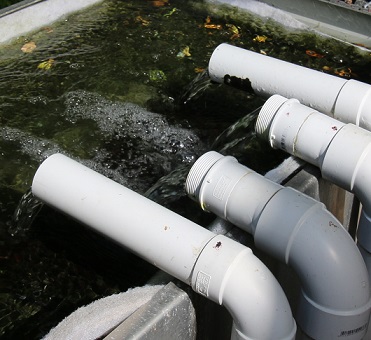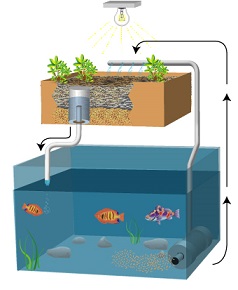A Complete Food Production System
 Aquaponics allows you to grow both plants (eg. vegetables) and fish in the same system. It can be operated on a small scale at home to feed a family, or on a large scale as a commercial farm. This is a complicated way of growing though, with significant benefits, but also challenges. You can do a lot more with less land, but you do need more equipment and technical know how. Aquaponics allows you to grow both plants (eg. vegetables) and fish in the same system. It can be operated on a small scale at home to feed a family, or on a large scale as a commercial farm. This is a complicated way of growing though, with significant benefits, but also challenges. You can do a lot more with less land, but you do need more equipment and technical know how.
Fourteen Things to Consider when Growing Fish in Aquaponics.
- Different fish species have different requirements: some tolerate impurities or lower levels of oxygen in the water than others; but as a rule, you will have faster growing, healthier fish, when you manage the water more carefully, irrespective of what type of fish you are growing.
- Generally, don’t mix species of fish in the same tank. Choose something that suits your needs then manage conditions for that species.
- Your choice of fish should depend upon both what your system is suited to, and what you want to harvest. If growing fish for your own use, you may consider what you like to eat. If growing to sell, you may consider what is going to be easiest to sell, and what will bring the best price.
- Low oxygen level in the water is a common way that fish are killed in aquaponics. Pumps must continue running to keep oxygen levels up. There are many reasons why pumps may not run for a period; and provision needs to be made to manage and avoid any situation where the pump stops (eg. Power failures, disconnecting a pump for repair, unplugging a pump). You may consider having a battery or petrol powered pump as a back-up.
- Over feeding fish is another relatively common way fish are made sick or killed. Any food that is not eaten by fish within 3-5 minutes should be removed. Uneaten food decomposes in water, causing an increase in ammonia which can poison fish.
- pH levels need to be stable. Many fish species can adjust to gradual changes in water pH, but may be killed by fast changes.
- Water temperature should not change rapidly. Some fish species will tolerate higher or lower temperatures than others, but most do not respond well to quick changes.
- Don’t put too many fish in a body of water. Overstocking makes it far more difficult to maintain water quality and control disease.
- Smaller tanks are more prone to variable conditions; and as such this makes it easier to grow fish in larger volumes of water. If you start with a small system, keep it in a place where temperatures are more stable (eg. a veranda or inside a shed, out of the sun), and under stock the tank rather than overstocking, so you have better control over water quality.
- Aquatic animals commonly grow better when the water contains higher levels of oxygen (ie. DO or Dissolved Oxygen). Colder water can hold more oxygen than warmer water however water temperature can also be a factor in growing fish or crustaceans. Warm water animal species have often evolved to cope better with lower levels of dissolved oxygen. Water can only hold a certain amount of oxygen though, and animals living in the water are constantly removing and lowering oxygen levels. This makes it critical for you to continually replace the oxygen that is being removed. You do this by aerating the water. Dropping water into a tank from a return pipe can help and bubbling air from an outlet at the bottom of a tank can also.
- Ammonia build up in water can be a problem, particularly in warmer water. Levels of 1ppm are dangerous. Any level of total ammonia above 0.5ppm can be considered dangerous for many species. Different species can have different levels of susceptibility. Bacteria in the water do convert Ammonia into nitrate which feeds algae; but there needs to be a balance in this cycle so ammonia doesn’t build.
- Productivity is affected by stocking rated. Overstocking can reduce growth rates.
- Water hardness is a factor that can affect the ability to grow animals. Hardness may have originally been a term used to refer to how well soap lather up in water - which is essentially related to the concentration of calcium and magnesium. In aquaculture it refers to the total concentration calcium carbonate in terms of parts per million (ppm). Soft water is 0-55ppm. Hard water is 200 to 500ppm. Calcium is needed for bones of fish and the shells of crayfish. Some types of animals need it more than others and as such, some animals need harder water than others. Fresh and saltwater crayfish, for instance, tend to need hard water at a higher ppm.
- The water pH required for growing plants needs to have a level of compatibility with the pH require for growing fish (or other aquaculture). Keep in mind that the water pH may also be changed by the system as it goes from hydroponics to aquaculture or aquaculture to hydroponics.

|
Latest
Categories
Archive
|